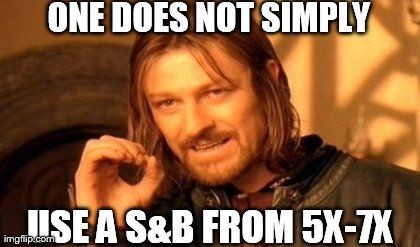I think S&B cheated here: (7-5)/5*100 = 40%. I would call it 7-25. The reason is that from 5x to approximately 7x the field of view remains the same. The sight picture just gets smaller towards to 5x.
Here is a video I shot
<span style="color: #3366FF">http://youtu.be/R3HjL7ueZgY</span>
Disclaimer: I am no pro or even close to it. Shooting is my hobby, not a profession. This video is not an advice or anything else. It's just a product of my boredom.
<span style="font-style: italic"><span style="font-weight: bold">Why did not they stop at 7x? Does anybody see any use of smaller magnification with same field of view?</span> </span>
<span style="font-weight: bold">!!! FOR THOSE WHO WANTS TO SPARE SOME TIME READING THE ANSWER IS HERE: Study the phrase "exit pupil" and look up the multiple advantages of a larger size, when needed. Advantages that may not be apparent unless used with auxiliary equipment. Not all users have the limited requirements that you(or I) do. (by Hellbender)</span>
Another thing I figured out lately which may help to avoid such "surprises" if you do not have a chance to look through the scope before buying one. You can use scope specs to roughly estimate amount of tunneling:
1. Take high magnification and divide by low (e. g. for S&B in question: 25 / 5 = 5)
2. Take field of view on low magnification and divide by FOV on high (5.3 / 1.5 = 3.5)
3. Compare the numbers. They should be close. For this scope FOV ratio is 3.5. Now if we substitute 5 with 7 in step one (7 is where the tunneling becomes apparent) we get 25/7 = 3.57 which is very close to FOV ratio (inverse of cause)
Not impressed? See NF NSX 3.5-15x50 as an example:
15/3.5 = 4.28
8.4/2.2 = 3.81
S&B 3-20x50:
20/3 = 6.67
13/2.1 = 6.19
From calculations above I would say that S&B 5-25 is 3.5x scope, NF NSX 3.5-15 is 3.8x and S&B 3-20x50 is 6.19x scope in terms of magnification range without loosing field of view.
Here is a video I shot
<span style="color: #3366FF">http://youtu.be/R3HjL7ueZgY</span>
Disclaimer: I am no pro or even close to it. Shooting is my hobby, not a profession. This video is not an advice or anything else. It's just a product of my boredom.
<span style="font-style: italic"><span style="font-weight: bold">Why did not they stop at 7x? Does anybody see any use of smaller magnification with same field of view?</span> </span>
<span style="font-weight: bold">!!! FOR THOSE WHO WANTS TO SPARE SOME TIME READING THE ANSWER IS HERE: Study the phrase "exit pupil" and look up the multiple advantages of a larger size, when needed. Advantages that may not be apparent unless used with auxiliary equipment. Not all users have the limited requirements that you(or I) do. (by Hellbender)</span>
Another thing I figured out lately which may help to avoid such "surprises" if you do not have a chance to look through the scope before buying one. You can use scope specs to roughly estimate amount of tunneling:
1. Take high magnification and divide by low (e. g. for S&B in question: 25 / 5 = 5)
2. Take field of view on low magnification and divide by FOV on high (5.3 / 1.5 = 3.5)
3. Compare the numbers. They should be close. For this scope FOV ratio is 3.5. Now if we substitute 5 with 7 in step one (7 is where the tunneling becomes apparent) we get 25/7 = 3.57 which is very close to FOV ratio (inverse of cause)
Not impressed? See NF NSX 3.5-15x50 as an example:
15/3.5 = 4.28
8.4/2.2 = 3.81
S&B 3-20x50:
20/3 = 6.67
13/2.1 = 6.19
From calculations above I would say that S&B 5-25 is 3.5x scope, NF NSX 3.5-15 is 3.8x and S&B 3-20x50 is 6.19x scope in terms of magnification range without loosing field of view.
Last edited:






